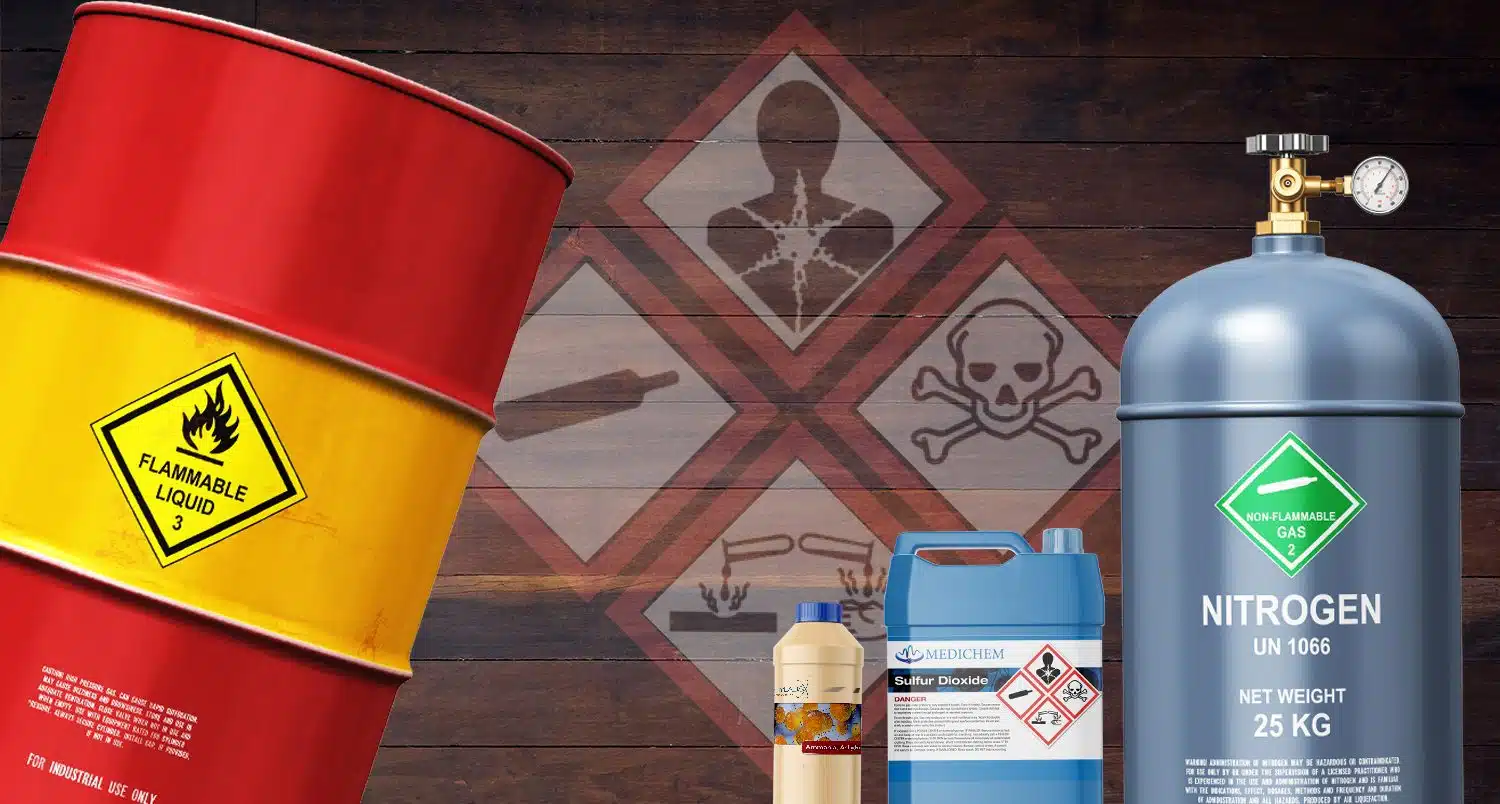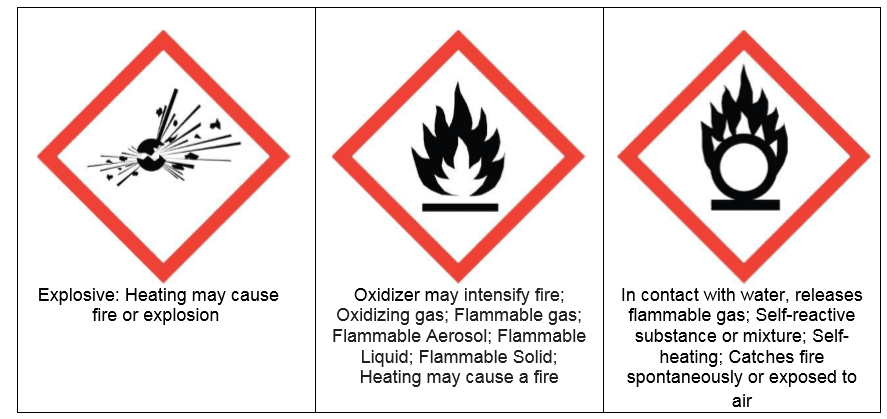
GHS (Globally Harmonized System) Chemical Labeling Compliance
Until 2003, chemical labels were regulated by standards created by individual nations, usually with advice and commentary from related industry groups. We now find ourselves in an era of globalization, in which a globally interconnected supply chain accomplishes the manufacturing, packaging, transport, sale, and use of chemicals and chemical products.
Costs of GHS labeling are varied. The European Union, the United States, Canada, and Asian countries have all moved towards GHS chemical labeling compliance at different rates, and with different final standards.
Although all of these packaging guidelines are GHS compliant, they do have subtle differences in language, size, and orientation rules – when a company ships chemicals to each of these countries, distinct packaging is needed for each location. From shipment to shipment, packaging an unpredictable amount of specific chemicals with unique GHS labels is a process that can be difficult to prepare for, without the appropriate packaging solution.
Benefits of the GHS Chemical Labeling Compliance Standards
Increased Safety, Communication, and Trade Facilitation
While the industry is required to bear the costs of re-assessing and re-packaging chemical products, it is important to note that there are benefits of GHS chemical labeling compliance.
- GHS allows for a simpler export of chemical products to foreign markets, with no more country-specific documentation and testing standards, workplace safety standards, and environmental standards.
- GHS further protects human health and the environment with consistent international hazard communication to inform all users throughout the chemical supply chain to the presence of a hazard. Compliance also minimizes exposure and risk to those hazardous chemicals through safer transportation, handling, and use.
- In all participating countries, GHS ensures the safe management of chemicals through identifying hazards and communicating them. This is particularly useful for countries without well-developed regulatory systems.
- GHS provides increased and simplified international trade, leading to improved communication and growth in international markets for companies seeking to import and export chemical goods.
Mandated GHS Label Requirements
• Product Identifier
The ingredient name or number of the pure chemical substance or chemical mixture. The technical name(s) must be harmonized with IUPAC, CAS, and with the technical name(s) listed on the MSDS sheet. It must also be aligned with the UN Proper Shipping Name if the chemical is regulated under the United Nations Recommendations on the Transport of Dangerous Goods (UNRTDG). The Product Identifier is meant to prevent accidental or uninformed exposure. A worker, shipper, or supply chain partner must be able to identify the chemical and recognize its potential hazard accurately.
• GHS Pictograms
Each red, black, and white point-set, square-shaped pictogram conveys information about particular hazardous risks associated with a chemical. In combination with the signal word “Danger” or “Warning,” the pictogram communicates the severity of the risk and is meant to prevent accidental or uninformed exposure. More than one pictogram may be used on the same chemical label, if applicable. The size of the pictogram, and other label elements, should be proportionate to the physical dimensions of the label. Examples:

• Signal Words
Either “Danger” or “Warning” used to emphasize hazards and indicate the relative level of severity of the hazard, assigned to a GHS hazard class and category: “Danger” for the more severe hazards, and “Warning” for the less severe hazards. Only one signal word corresponding to the class of the most severe hazard should be used on a label.
• Hazard Statements
These phrases describe the nature and degree of the hazard posed by the chemical. All hazard statements should be included on the label for a substance/mixture possessing more than one hazard. Example of a hazard statement: “Heating may cause an explosion.”
• Precautionary Statement
These statements must relate to the GHS pictogram and further describe measures that should be taken to minimize or prevent risks associated with the hazard. The number of precautionary statements should be kept to a maximum of six. Example: “Keep away from heat/sparks/open flames/hot surfaces – no smoking” in relation to a pictogram that shows Explosive Danger and a Hazard Statement such as “Heating may cause an explosion.”
• Supplier Information
Each chemical container, including secondary packaging such as crates and master cases, must include a GHS label printed with the Supplier Information. This must include the name, address, and telephone number of the manufacturer or supplier of the product.
• Supplementary Information
Additional product information volunteered by the manufacturer, supplier, or other responsible parties. It is acceptable for the manufacturer to make a statement that is not harmonized with the GHS standards. However, the statement must not conflict with GHS standards.
Label Size Requirements
Most countries do not require minimum label sizes for GHS labels; however, they stipulate that GHS labels are easily readable. In the European Union, label minimums are outlined, depending on the capacity of the container. Within the European Union, the proper minimum label dimensions based on container size are depicted on the chart below:

Printing GHS Labels In-House
The variety of GHS label formats and size configurations has made the prospect of printing labels in-house, tailored for each chemical product, attractive to many chemical manufacturers. There are a couple of options for printing GHS labels as part of an in-house packaging process:
Option One: Printing Labels with a Barcode Printer
In this scenario, a barcode label printer is used to print pictograms, signal words, manufacturer address, and other text in one-color: black. Secondary and additional colors, red for the GHS pictograms and other colors for logos and branding, are pre-printed onto a roll of labels.
This pre-printed roll is inserted on a thermal transfer barcode printer, which prints the black-colored portion of the label, including the black section of the GHS pictograms, signal words, hazard warning, and other text with a black-colored thermal transfer ribbon.
This solution requires a large inventory of pre-printed labels, and a separate pre-printed roll for each variation in chemical label: different countries, languages, pictograms each get their own pre-printed roll. This presents a logistical challenge in a production setting, where packaging staff is required to identify and select the correct pre-printed label roll from among the many rolls on warehouse shelves for each batch.
Option Two: Printing Labels with a Full-Color Label Printer
A full-color digital label printer grants the capability of printing variable GHS labels with maximum flexibility to comply with GHS labeling regulations, along with customer and retailer demand.
Chemical manufacturers are finding that a full-color label printer provides them the most flexibility for printing GHS labels for international and domestic markets, wholesalers, and private label retailers.
A four-color or five-color printer can satisfy BS5609, GHS, private, and custom labeling requirements at the same time. However, an in-house, full-color digital label printer gives chemical manufacturers the capacity to print labels that integrate all GHS required elements and create graphic-rich primary display panels that include logos and branding the same label printing process.
Questions? Let us know, we’re here to help!
At AstroNova, we offer a total labeling solution. We provide the tools you need to integrate production efficiencies into your business and keep up with industry demands from a wide variety of label printers, materials, technical support, training, and a library of support videos. Contact us to schedule a free, web-based demonstration and to speak with one of our specialists!


